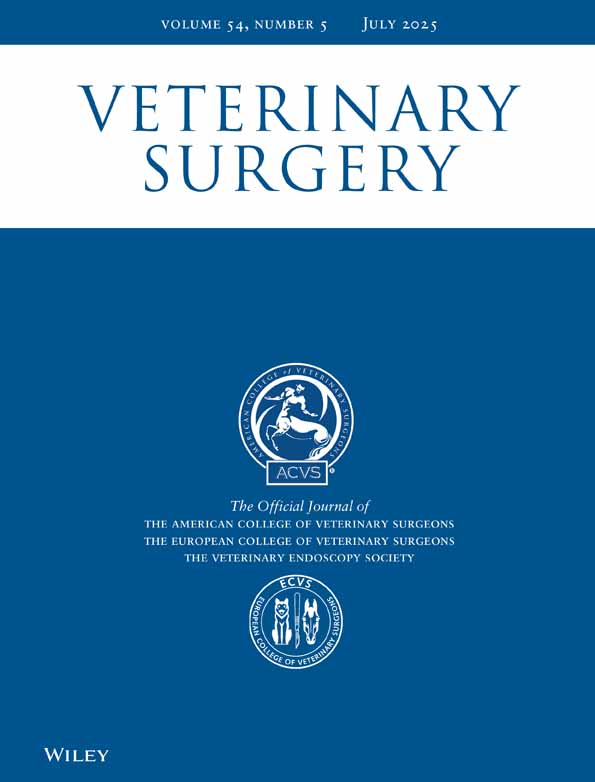Influence of Bolt Tightening Torque, Wire Size, and Component Reuse on Wire Fixation in Circular External Fixation
Supported by a grant from the Department of Clinical Sciences Research Fund, College of Veterinary Medicine, North Carolina State University, Raleigh, NC.
Presented in part at the American College of Veterinary Surgeons Veterinary Symposium, Chicago, IL, October 2001.
Address reprint requests to Denis J. Marcellin-Little, DEDV, College of Veterinary Medicine, North Carolina State University, 4700 Hillsborough St, Raleigh, NC 27606.
Abstract
Objectives— To evaluate the effects of bolt torque, wire size, and component reuse on the ability to maintain wire tension in 3 external skeletal fixation systems.
Study— Design Biomechanical study.
Methods— Yield strength in tension of 1.0-, 1.2-, 1.5-, and 1.6-mm-diameter wires, and yield strength in torque of Hofmann Small Bone Fixation (SBF) cannulated and slotted bolts and IMEX regular and miniature bolts were determined on a testing machine. The minimum bolt tightening torque needed to prevent wire slippage at clinically recommended wire tensions was determined. Components were tested 10 times, and loads at slippage were recorded.
Results— The IMEX system required a mean of 8 Nm of bolt tightening torque to maintain 900 N (1.6-mm wires). The SBF system required a mean of 3 Nm bolt torque to maintain 300 N (1.0-mm wires) and 5 Nm to maintain 600 N (1.2-mm wires). The SBF cannulated bolt required 9 Nm of torque to maintain 900 N (1.5-mm wires). The SBF slotted bolts could only maintain 800 N before yield. The IMEX miniature system required a mean bolt torque of 1.1 Nm to maintain 300 N. The cannulated and slotted bolts from both manufacturers failed to maintain 70% of initial wire tension after 7 and 4 uses, respectively.
Conclusions— The IMEX systems and the SBF system using 1.0- and 1.2-mm wires could maintain clinically recommended wire tension safely. Only the IMEX system could maintain clinically recommended wire tension safely using 1.5- or 1.6-mm wires.
Clinical Relevance— The SBF system using 1.0- and 1.2-mm wires and the IMEX system using all wire sizes can maintain clinically relevant wire tension. The SBF system using 1.5-mm wires could not. Cannulated and slotted bolts should not be used more than 6 and 3 times, respectively. Nuts should not be reused.
Circular external fixation (CEF) has gained acceptance in veterinary medicine for treatment of fractures and for correction of limb deformities.1–6 CEF offers the advantage over other surgical methods of allowing assembly of complex frames that allow manipulation of bone fragments in multiple planes while causing minimal soft tissue trauma. CEF relies on tensioned small-diameter wires and half-pins to hold bone fragments. The stiffness of the small-diameter wires is significantly increased when tension is applied to the wires.7,8 Appropriate wire tension is critical to maintain frame stiffness and decrease complications.7–9 The tension applied to CEF wires should be greater with larger wire size, ring diameter, frame length, animal patient weight, and bone size. Whereas the tension necessary to optimize frame stiffness has been determined experimentally,10 the optimal wire tension for use in clinical patients has not. However, empirical recommendations have been made.11
Cannulated or slotted bolts fasten the tensioned wires to the surface of the ring of the supporting frame. Failure of the wire/bolt/ring interface results in wire slippage and a subsequent loss of wire tension. The tightening torque required to prevent wire slippage has not been determined for the various bolts of the small-scale CEF systems used in veterinary orthopedics. The maximum torque that a surgeon can generate with a 100-mm-long wrench has been reported to be 7.8 Newton meters (Nm).12,13 An informal test, however, recorded a mean torque of 18 Nm for 13 individuals using a 125-mm-long wrench (Technical report 124; IMEX Inc, Longview, TX). In engineering, by convention, the maximum working torque on a fastener should not exceed 60% to 80% of its yield strength.14–16 The difference between the amount of tightening torque on the CEF wire fixation bolts required to prevent slippage of tensioned wires and the amount of torque that these bolts can withstand before mechanical failure is not known. Clinically, wire fixation bolts sometimes fail during the process of tightening, especially when a large amount of wire tension is anticipated (leading the surgeon to apply a large amount of bolt tightening torque) or when the bolts have been previously used.
We hypothesized that the small-scale CEF systems used in veterinary orthopedics cannot maintain wire tension within the conventional safety margin. To test this hypothesis, (1) we determined the failure point in torque of 4 models of wire fixation bolts from 2 manufacturers; (2) we determined the minimum amount of tightening torque needed to prevent slippage at the wire/bolt/ring interface; (3) we determined whether this torque value was within the reasonable safety margin of these bolts; and (4) we determined if re-using rings, bolts, and nuts led to increased slippage or early failure of bolts.
Materials and methods
Wire yield
Wires were tested to failure on a materials testing machine (model 1122; Instron Corporation, Inc, Canton, MA) to determine their yield strength. Five olive wires with diameters of 1.0, 1.2, 1.5 (Small Bone Fixation [SBF] system; Hofmann s.r.l., Monza, Italy), and 1.6 mm (IMEX Inc) were evaluated. The wires were placed through a 2-mm drill hole in a metal plate that was mounted on a stand attached to the base of the materials testing machine. The free end of the wire was secured by a clamp of custom design, which was attached to a 5 kN load cell mounted in the crosshead. The crosshead was distracted at a rate of 1 mm/min until the wire yielded. The yield strength was determined to be the load at which there was a reduction in the slope of the load/deformation curve. Load cell output and crosshead position were collected digitally on a personal computer using a commercial software package (TestWorks4; MTS Systems Corporation, Eden Prairie, MN). The mean load at yield in Newtons (N) was recorded for each wire diameter. This test also demonstrated there was negligible wire slippage in the testing jig.
Wire fixation bolt yield
Cannulated fixation bolts from the SBF and IMEX miniature CEF systems, slotted bolts from the SBF CEF system, and combination cannulated/slotted fixation bolts from the IMEX CEF system were tested to determine their tightening torque at failure using factory-calibrated torque wrenches (Flat beam torque wrench, model 5347A22; McMaster Carr, Atlanta, GA; Dial torque wrench model 752LDIN; Consolidated Devices, Inc, City of Industry, CA). Bolts were placed through a ring hole, and a nut was placed on the threads. The bolt head was held stationary, while the nut was turned until the bolt failed. Five bolts of each type were tested. The bolts were used as they came from the manufacturer and not cleaned or lubricated. A peak torque meter on the wrench recorded the torque at failure for each bolt type. Maximum safe torque was defined as 75% of the bolts' tightening torque at failure.
Wire slippage
A pilot study was conducted on the materials testing machine to determine the bolt tightening torque required to prevent wire slippage when traction was placed on the wires to reproduce the load recommended for clinical use. The traction placed on the wires was at least 300 N (31 kg) for 0.9-mm (0.035-inch), 1.0-mm, and 1.1-mm (0.045-inch) wires, 600 N (61 kg) for 1.2-mm wires, and 900 N (92 kg) for 1.5-mm and 1.6-mm wires.11 The IMEX system was tested using a 1.6-mm-diameter wire with fixation bolts that are both cannulated and slotted. The SBF system was tested using 1.0-, 1.2-, and 1.5-mm-diameter wires with both cannulated and slotted wire fixation bolts. The IMEX miniature system was tested using wire diameters of 0.9 mm (0.035 inch) and 1.1 mm (0.045 inch) with cannulated fixation bolts. This resulted in 10 ring/wire/bolt configurations. A new bolt, nut, ring hole, and wire segment was used for each iteration. A factory-calibrated torque wrench was used to tighten the nuts on the wire fixation bolt to the desired torque. Specimens were tested in random order. The wire/bolt/ring construct was held by a solid frame attached to the base of the materials testing machine. The free end of the wire was grasped by a clamp attached to the load cell mounted in the crosshead. The crosshead was distracted at a rate of 1 mm/min to improve the accuracy of the measurements, and the load at which slippage occurred was recorded. Slippage was defined as an abrupt flattening of the load/deformation curve. Wire slippage within the testing machine clamp was assumed to be negligible, based on the wire yield tests.
The bolts were tightened to progressively increasing torque values, until there was no wire slippage at the loads recommended for clinical use. The torque value at which slippage was prevented was recorded and used as the central value in the experimental portion of the study.
Based on these data, the range of tightening torques evaluated for each group was determined by choosing values lower and higher than the central value and spanned the range of torques that the particular bolt type could withstand without failure (1-5). Each configuration was examined 5 times at each torque value in the same manner as described for the pilot study.
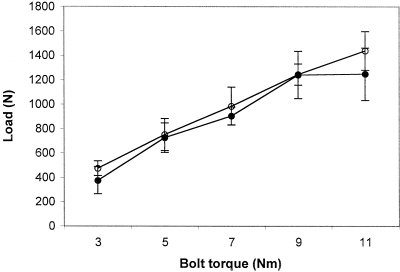
Influence of bolt tightening torque on wire slippage for the IMEX system using 1.6-mm wires and cannulated (○) or slotted (•) bolts.
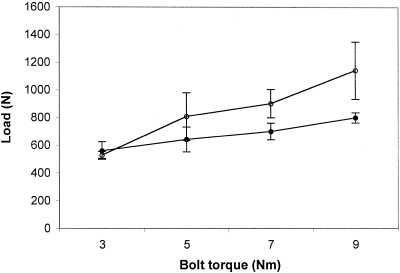
Influence of bolt tightening torque on wire slippage for the SBF system using 1.5-mm wires and cannulated (○) or slotted (•) bolts.
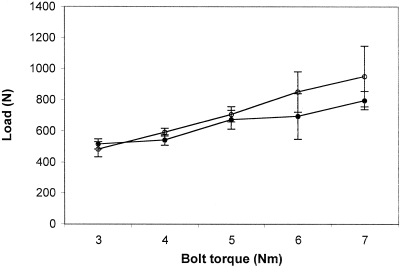
Influence of bolt tightening torque on wire slippage for the SBF system using 1.2-mm wires and cannulated (○) or slotted (•) bolts.
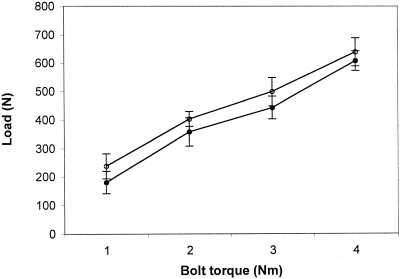
Influence of bolt tightening torque on wire slippage for the SBF system using 1.0-mm wires and cannulated (○) or slotted (•) bolts.

Influence of bolt tightening torque on wire slippage for the IMEX miniature system using 0.9-mm (○) or 1.1-mm (□) wires and cannulated bolts.
Component reuse
To evaluate if component re-use led to increased slippage, a randomly selected bolt / nut / ring hole combination was chosen for each type of bolt, and the tension required to cause wire slippage was determined for ten consecutive uses (Fig 6). A new wire segment was used for each repetition, and the wire fixation bolts were tightened before each repetition to the safe torque corresponding to the value derived in the previous set of experiments (Table 1). The load at which the wire slipped was recorded for each configuration.
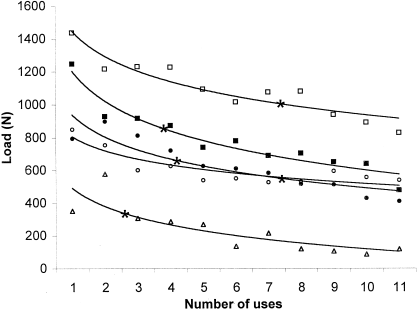
Maximum loads maintained before wire slippage by circular external fixation bolts. The loads maintained over 11 uses by IMEX cannulated (□), IMEX slotted (▪), SBF cannulated (○), SBF slotted (•), and IMEX miniature systems (▵) are represented. Trendlines were calculated by the spreadsheet software using polynomial functions. Asterisks represent 70% of the initial loads maintained before wire slippage.
| Bolt Type | Wire Size (mm) | Yield Torque (Nm) | Safe Torque* (Nm) | Torque Required to Maintain Wire Tension†(Nm) |
|---|---|---|---|---|
| IMEX | 1.6 | 28.1 ± 3.0 | 21 | 8 |
| SBF cannulated | 1.5 | 9.8 ± 0.3 | 7.4 | 9 |
| 1.2 | 5 | |||
| 1.0 | 3 | |||
| SBF slotted | 1.5 | 10.7 ± 0.3 | 8.0 | NA‡ |
| 1.2 | 5 | |||
| 1.0 | 3 | |||
| IMEX mini | 0.9 and 1.1 | 2 ± 0.2 | 1.5 | 1.1 |
- Abbreviations: SBF, Small Bone Fixation; NA, not applicable.
- *The safe torque represents 75% of the torsional yield torque.14
- †900 N for 1.6- and 1.5-mm-diameter wires, 600 N for 1.2-mm-diameter wires, and 300 N for 1.1-, 1.0-, and 0.9-mm-diameter wires.11
- ‡Bolt failed before 900 N of wire tension could be maintained.
Results
Wire yield
The mean (±SD) yield load in tension of wires was 889 ± 36.3 N for 1.0-mm wires, 1,363 ± 33.7 N for 1.2-mm wires, 2,033 ± 34.0 N for 1.5-mm wires, and 2,166 ± 74.0 N for 1.6-mm wires. There was negligible wire slippage in the testing jig.
Wire fixation bolt failure
The mean peak tightening torque at which each bolt failed and the maximum safe torques, set by convention at 75% of tightening torque at failure, are reported in Table 1. The mode of failure of each type of bolt differed. Failure of the IMEX and IMEX miniature bolts occurred by fracture through the cannulated portion of the bolt shaft. The SBF cannulated and slotted bolts both failed by fracture through the threaded portion of the bolt shaft just proximal to the location of the nut.
Wire slippage
The maximum axial load placed on the wires (wire tension) was 300 N (31 kg) for 0.9-mm (0.035 inch), 1.0-mm, and 1.1-mm (0.045 inch) wires, 600 N (61 kg) for 1.2-mm wires, and 900 N (92 kg) for 1.5- and 1.6-mm wires.11 This represented 34%, 44%, 44%, and 42% of ultimate yield strength of the 1.0-, 1.2-, 1.5-, and 1.6-mm-diameter wires, respectively. At these wire tensions, the minimum bolt tightening torque required on the IMEX system to prevent wire slippage was 8 Nm for 1.6-mm wires using both cannulated and slotted bolts (Fig 1). The minimum tightening torque required on the SBF nuts to prevent wire slippage was 9 Nm for 1.5-mm wires using cannulated SBF bolts (92% of the peak failure in tightening torque of the bolt –Fig 2), 5 Nm for 1.2-mm wires using both cannulated and slotted SBF bolts (Fig 3), and 3 Nm for 1.0-mm wires using both cannulated and slotted SBF bolts (Fig 4). The interface between 1.5-mm wires and the SBF slotted bolts failed at 800 N (82 kg) and could not maintain the predetermined wire tension of 900 N (Fig 2). The minimum tightening torque required on the IMEX miniature nuts to prevent wire slippage was 1.1 Nm for both the 0.9-mm (0.035 inch) and 1.1-mm (0.045 inch) wires (Fig 5). The IMEX miniature wire fixation bolts deformed the wires as they passed through the cannulated portion of the bolt. The hole in the ring is wider than the diameter of the shaft of the bolt, allowing the wire to be bent by a shearing action as the small bolt was recessed into a large hole. The amount of load that could be maintained by the IMEX miniature wire fixation bolts varied, depending on the magnitude of wire deformation.
Component reuse
The load that constructs held without wire slippage decreased with component reuse (Fig 6). Cannulated bolts maintained wire tension better after repeated use than slotted bolts. Slotted bolts were deformed at the head/shaft interface during use because of asymmetrical loading of the head. This deformation possibly led to a diminished ability to convert bolt torque into clamping force on the wire. IMEX and the SBF cannulated bolts failed to maintain 70% of initial wire tension after 6 or 7 uses. IMEX and SBF slotted bolts failed to maintain 70% of initial wire tension after 3 or 4 uses. IMEX miniature bolts failed to maintain 70% of initial wire tension after 2 uses.
Discussion
Wire tension is an important part of the stability of CEF because the diameter of the wires is smaller than the diameter of the pins used in conventional external fixation.7–9,13 This study was aimed at evaluating multiple aspects of wire tension for 3 CEF systems used in small animal surgery, including wire yield and slippage, bolt yield, and component deformation after multiple uses.
To prevent wire slippage, sufficient friction must be present between wire, bolt head, and ring surface. Friction is a function of the friction coefficient of the surfaces in contact and preload. The friction coefficient is dependent on the design properties of the metal surfaces in contact and cannot be altered by the user. Preload, also called clamping force, is the tension along the axis of the bolt that leads to a compression of the wire between the bolt head and the surface of the ring. Preload is the result of the bolt's elastic tendency to return to its original length after it is stretched, as a consequence of tightening a nut on that bolt. The user can alter preload because it is a function of bolt tightening. The minimum tightening torque needed on the fixation bolts to maintain clinically relevant wire tension was determined. That torque was compared with the ultimate yield strength in torque of the bolts. Using 75% of ultimate yield as a safety factor,14–16 we determined whether the bolts could safely maintain the recommended tensions. The SBF system using 1.0- and 1.2-mm-diameter wires and the IMEX systems could maintain clinically recommended wire tension safely. The SBF system using 1.5-mm-diameter wires could not maintain wire tension within their safety factor because 92% of their ultimate yield strength was needed to maintain tension for cannulated bolts, and slotted bolts failed before they could maintain the appropriate amount of tension. Clinically, bolt failure may occur as the user attempts to tighten the nut on a SBF bolt used with a 1.5-mm-diameter wire. The average user could place a torque on bolts substantially higher than the maximum safe torque of the SBF and IMEX miniature bolts leading to mechanical failure of the bolts. The use of a calibrated torque wrench could help clinicians monitor the torque placed on wire fixation bolts. When using the SBF system in large dogs, additional strategies, such as the use of half pins, may be required to enhance overall frame stiffness.
Reusing components resulted in progressive loss of their ability to maintain wire tension. Our study did not attempt to determine which reused component among the bolt, nut, or ring had the greatest contribution to the loss of tension. Typically, the nut is the component of a fastener construct that contributes to the greatest loss of preload when it is reused.14–16 As a nut is tightened, its threads deform. On subsequent uses, this deformation results in an increased amount of friction between threads that resists turning. The result is that a greater proportion of the torque force is diverted to overcome this friction and not to develop preload on the fastener. As a consequence, the bolt is placed under torsion, not tension. If the nut is tightened to the appropriate level of torque, preload may be suboptimal and the wire will slip. If, conversely, the nut is tightened enough to ensure adequate preload, and therefore prevent wire slippage, the bolt will be under a higher amount of torsional strain and may fail.
The head of a slotted bolt deforms because of the asymmetrical loading of the wire under only one side of the head. This may explain why slotted bolts failed to maintain wire tension as well as the cannulated bolts. The authors recommend that cannulated bolts not be reused more than 6 times, slotted bolts not be reused more than 3 times, and nuts not be reused in a clinical setting.
During clinical use, wires are loaded transversely and often at high rates as the animal patient walks and jumps. The factors involved in wire fixation under these conditions are complicated and interdependent.17 Our study only evaluated the loads that could be maintained by wire fixation bolts during slow, axial tension and as such was not intended to completely describe the ability of the systems to maintain wire tension in vivo.
Acknowledgment
The authors thank Timothy R. Seaboch for technical assistance.



